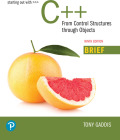
EBK STARTING OUT WITH C++
9th Edition
ISBN: 9780134996066
Author: GADDIS
Publisher: PEARSON CUSTOM PUB.(CONSIGNMENT)
expand_more
expand_more
format_list_bulleted
Concept explainers
Expert Solution & Answer
Chapter 16.3, Problem 16.6CP
Explanation of Solution
Function template:
In C++, a function template is referred as a “generic” function, which can work with different data types.
- While writing a function template, a programmer should use a “type parameter” to denote a “generic” data type instead of using the actual parameter.
- The compiler generates the code, when it encounters a function call to a function template. This code will handle the particular data type which is used in the function call.
- The compiler indentifies the argument type and generates the code to work with those types.
- The generated code is referred as “template function”.
Example:
For example consider the following function template for finding a cube of value:
template <class T>
T cube(T x)
{
return x * x * x ;
}
- A function template must begin with the keyword “template” and it is followed by a pair of angle brackets, which contains one or more “generic” data types...
Expert Solution & Answer
Want to see the full answer?
Check out a sample textbook solution
Students have asked these similar questions
Dijkstra's Algorithm (part 1). Consider the network shown below, and Dijkstra’s link-state algorithm. Here, we are interested in computing the least cost path from node E (note: the start node here is E) to all other nodes using Dijkstra's algorithm. Using the algorithm statement used in the textbook and its visual representation, complete the "Step 0" row in the table below showing the link state algorithm’s execution by matching the table entries (i), (ii), (iii), and (iv) with their values. Write down your final [correct] answer, as you‘ll need it for the next question.
4. |z + 5 - 5i| = 7
14.
dz,
C: |z❘
C: |z❘ = 0.6
ze² - 2iz
H
Chapter 16 Solutions
EBK STARTING OUT WITH C++
Ch. 16.1 - Prob. 16.1CPCh. 16.1 - Prob. 16.2CPCh. 16.1 - Prob. 16.3CPCh. 16.1 - Prob. 16.4CPCh. 16.1 - Prob. 16.5CPCh. 16.3 - Prob. 16.6CPCh. 16.3 - The following function accepts an i nt argument...Ch. 16.3 - Prob. 16.8CPCh. 16.3 - Prob. 16.9CPCh. 16.4 - Prob. 16.10CP
Ch. 16.4 - Prob. 16.11CPCh. 16 - Prob. 1RQECh. 16 - Prob. 2RQECh. 16 - Prob. 3RQECh. 16 - Prob. 4RQECh. 16 - What is unwinding the stack?Ch. 16 - What happens if an exception is thrown by a classs...Ch. 16 - How do you prevent a program from halting when the...Ch. 16 - Why is it more convenient to write a function...Ch. 16 - Why must you be careful when writing a function...Ch. 16 - The line containing a throw statement is known as...Ch. 16 - Prob. 11RQECh. 16 - Prob. 12RQECh. 16 - Prob. 13RQECh. 16 - The beginning of a template is marked by a(n)...Ch. 16 - Prob. 15RQECh. 16 - Prob. 16RQECh. 16 - Write a function that searches a numeric array for...Ch. 16 - Write a function that dynamically allocates a...Ch. 16 - Make the function you wrote in Question 17 a...Ch. 16 - Write a template for a function that displays the...Ch. 16 - Prob. 21RQECh. 16 - Prob. 22RQECh. 16 - Prob. 23RQECh. 16 - Prob. 24RQECh. 16 - T F All type parameters defined in a function...Ch. 16 - Prob. 26RQECh. 16 - T F A class object passed to a function template...Ch. 16 - Prob. 28RQECh. 16 - Prob. 29RQECh. 16 - Prob. 30RQECh. 16 - Prob. 31RQECh. 16 - T F A class template may not be derived from...Ch. 16 - T F A class template may not be used as a base...Ch. 16 - Prob. 34RQECh. 16 - Prob. 35RQECh. 16 - try { quotient = divide(num1, num2); } cout The...Ch. 16 - template class T T square(T number) { return T T;...Ch. 16 - template class T int square(int number) { return...Ch. 16 - Prob. 39RQECh. 16 - Assume the following definition appears in a...Ch. 16 - Assume the following statement appears in a...Ch. 16 - Prob. 1PCCh. 16 - Prob. 2PCCh. 16 - Prob. 3PCCh. 16 - Prob. 4PCCh. 16 - Prob. 5PCCh. 16 - IntArray Class Exception Chapter 14 presented an...Ch. 16 - TestScores Class Write a class named TestScores....Ch. 16 - Prob. 8PCCh. 16 - Prob. 9PCCh. 16 - SortableVector Class Template Write a class...Ch. 16 - Inheritance Modification Assuming you have...Ch. 16 - Prob. 12PCCh. 16 - Prob. 13PC
Knowledge Booster
Learn more about
Need a deep-dive on the concept behind this application? Look no further. Learn more about this topic, computer-science and related others by exploring similar questions and additional content below.Similar questions
arrow_back_ios
SEE MORE QUESTIONS
arrow_forward_ios
Recommended textbooks for you
 C++ Programming: From Problem Analysis to Program...Computer ScienceISBN:9781337102087Author:D. S. MalikPublisher:Cengage Learning
C++ Programming: From Problem Analysis to Program...Computer ScienceISBN:9781337102087Author:D. S. MalikPublisher:Cengage Learning EBK JAVA PROGRAMMINGComputer ScienceISBN:9781337671385Author:FARRELLPublisher:CENGAGE LEARNING - CONSIGNMENT
EBK JAVA PROGRAMMINGComputer ScienceISBN:9781337671385Author:FARRELLPublisher:CENGAGE LEARNING - CONSIGNMENT C++ for Engineers and ScientistsComputer ScienceISBN:9781133187844Author:Bronson, Gary J.Publisher:Course Technology Ptr
C++ for Engineers and ScientistsComputer ScienceISBN:9781133187844Author:Bronson, Gary J.Publisher:Course Technology Ptr Systems ArchitectureComputer ScienceISBN:9781305080195Author:Stephen D. BurdPublisher:Cengage LearningProgramming Logic & Design ComprehensiveComputer ScienceISBN:9781337669405Author:FARRELLPublisher:Cengage
Systems ArchitectureComputer ScienceISBN:9781305080195Author:Stephen D. BurdPublisher:Cengage LearningProgramming Logic & Design ComprehensiveComputer ScienceISBN:9781337669405Author:FARRELLPublisher:Cengage

C++ Programming: From Problem Analysis to Program...
Computer Science
ISBN:9781337102087
Author:D. S. Malik
Publisher:Cengage Learning

EBK JAVA PROGRAMMING
Computer Science
ISBN:9781337671385
Author:FARRELL
Publisher:CENGAGE LEARNING - CONSIGNMENT

C++ for Engineers and Scientists
Computer Science
ISBN:9781133187844
Author:Bronson, Gary J.
Publisher:Course Technology Ptr

Systems Architecture
Computer Science
ISBN:9781305080195
Author:Stephen D. Burd
Publisher:Cengage Learning


Programming Logic & Design Comprehensive
Computer Science
ISBN:9781337669405
Author:FARRELL
Publisher:Cengage